Digital Poster
RF Pulse Design, Parallel Transmission & B1 Shimming II
Joint Annual Meeting ISMRM-ESMRMB & ISMRT 31st Annual Meeting • 07-12 May 2022 • London, UK

| Computer # | ||||
|---|---|---|---|---|
2924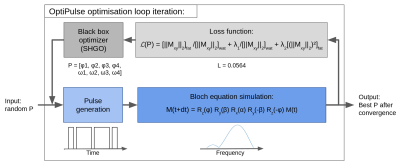 |
104 | OptiPulse: a flexible optimization framework for short water-selective radiofrequency pulse design
Xavier Sieber1,2, Jessica A. M. Bastiaansen1,2,3,4, Christopher W. Roy1,2, Jonas Richiardi1,2, Matthias Stuber1,2, and Ruud B. van Heeswijk1,2
1Department of Medical Radiology, Lausanne University Hospital (CHUV), Lausanne, Switzerland, 2University of Lausanne (UNIL), Lausanne, Switzerland, 3Department of Diagnostic, Interventional and Pediatric Radiology (DIPR), Inselspital, Bern University Hospital, University of Bern, Bern, Switzerland, 4Translational Imaging Center, Sitem-insel, Bern, Switzerland
We present a flexible optimization framework to design spectral-selective radiofrequency pulses using numerical optimization on Bloch equation simulation. The RF pulse performance is assessed using a composite loss function for both fat suppression and power requirement. The framework was used to design three binomial (1-1, 1-2-1 and 1-3-3-1) and one cubic B-splines interpolated RF pulses. These pulses were then tested in vitro as well as in vivo in the knee and in the heart, where they demonstrated robust fat suppression comparable to a state-of-the-art water-selective pulse.
|
||
2925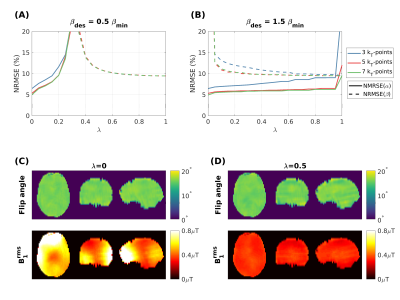 |
105 | Pulse design for joint optimization of semisolid saturation and free water rotation
David Leitão1,2, Raphael Tomi-Tricot1,3, Pip Bridgen1, Tom Wilkinson1, Patrick Liebig4, Rene Gumbrecht4, Dieter Ritter4, Sharon Giles1, Ana Baburamani1, Joseph V. Hajnal1,5, and Shaihan J. Malik1,5
1Biomedical Engineering and Imaging Sciences, King's College London, London, United Kingdom, 2London Collaborative Ultra high field System (LoCUS), London, United Kingdom, 3MR Research Collaborations, Siemens Healthcare Limited, Frimley, United Kingdom, 4Siemens Healthcare GmbH, Erlangen, Germany, 5Centre for the Developing Brain, King's College London, London, United Kingdom
In MT imaging, particularly at ultra-high field, results can be influenced by spatial variations in both (1) on-resonance flip angle and (2) RF saturation specified by B1rms including on- and off-resonance contributions. Conventional pulse design with parallel transmission focuses on homogenizing flip angle (α) distributions but does not explicitly account for B1rms distribution.
In this work we propose a generalized pulse design framework that considers both α and B1rms and apply it to achieve uniform excitation and saturation at the same time. Performance is confirmed in phantom experiments at 7T, resulting in more uniform MTR compared to conventionally-designed pulses. |
||
2926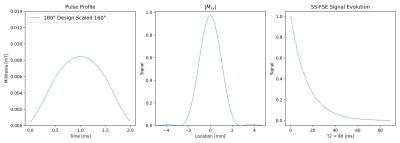 |
106 | Design of Novel RF Pulse for Fetal MRI Refocusing Trains using Rank Factorization (SLfRank) to Reduce SAR and Improve Image Acquisition Efficiency
Sebastian Diaz1, Yamin Arefeen2, Borjan Gagoski3,4, Ellen Grant3,4, and Elfar Adalsteinsson2,5,6
1Department of Biomedical Engineering, University of Arizona, Tucson, AZ, United States, 2Department of Electrical Engineering and Computer Science, Massachusetts Institute of Technology, Cambridge, MA, United States, 3Department of Radiology, Harvard Medical School, Boston, MA, United States, 4Fetal-Neonatal Neuroimaging and Developmental Science Center, Boston Children's Hospital, Boston, MA, United States, 5Harvard-MIT Health Sciences and Technology, Massachusetts Institute of Technology, Cambridge, MA, United States, 6Institute for Medical Engineering and Science, Massachusetts Institute of Technology, Cambridge, MA, United States
Fetal MRI is inherently time-constrained due to unpredictable motion and comfort concerns. Single-shot spin-echo sequences address these concerns by rapidly acquiring images with desired tissue contrast. However, these sequences typically operate at specific absorption rate (SAR) limitations due to a train of refocusing pulses, which impose long TR times and reduce acquisition efficiency. This study leverages SLfRank, the use of ranked factorization to jointly solve for SLR bi-coupled spin parameters, to design refocusing profiles that reduce SAR while maintaining slice-profile performance. The proposed refocusing pulse reduced SAR by over 20% while producing similar image quality to the standard clinical sequence.
|
||
2927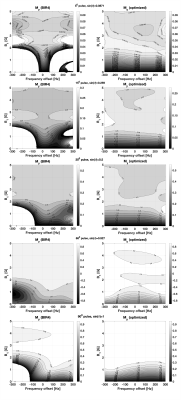 |
107 | Optimal control pulse design as a low power alternative to BIR4 excitation pulses
Vencel Somai1,2, Alan J Wright1, Ming Li Chia1, and Kevin M Brindle1,3
1CRUK CI, University of Cambridge, Cambridge, United Kingdom, 2Department of Radiology, University Of Cambridge, Cambridge, United Kingdom, 3Department of Biochemistry, University of Cambridge, Cambridge, United Kingdom
The BIR4 pulse achieves adiabatic excitation over a moderate frequency range but has a relatively high adiabatic threshold, which is demanding on the hardware and deposits significant energy when the repetition rate is high. We show here using simulations and an experiment in vivo that optimal control can provide a better alternative with a significantly lowered adiabatic threshold.
|
||
2928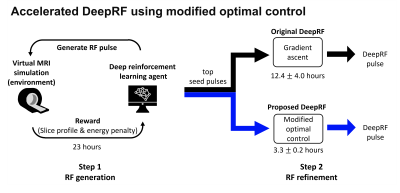 |
108 | Accelerated DeepRF using modified optimal control
Jiye Kim1, Dongmyung Shin1, Hongjun An1, Hwihun Jeong1, Minjun Kim1, and Jongho Lee1
1Department of Electrical and Computer Engineering, Seoul National University, Seoul, Korea, Republic of
DeepRF1 is a recently proposed RF pulse design method using deep reinforcement learning and optimization, generating RF defined by a reward (e.g., slice profile and energy constraint) from self-learning. Here, we proposed an accelerated algorithm for DeepRF that utilizes a modified optimal control, replacing the computationally complex gradient ascent-based optimizer. The new algorithm is tested for slice-selective inversion and slice-selective excitation and compared with original DeepRF and SLR RF pulses, reporting improved computation efficiency while preserving performances. Additionally, a short-duration B1-insensitive inversion pulse, which was difficult to produce in conventional RF algorithms, is designed to demonstrate the usefulness of DeepRF.
|
||
2929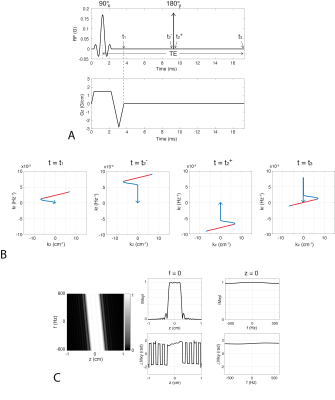 |
109 | Extension of k-space formalism with refocusing RF pulses
Zungho Zun1 and Taehoon Shin2,3,4
1Weill Cornell Medicine, New York, NY, United States, 2Division of Mechanical and Biomedical Engineering, Ewha Womans University, Seoul, Korea, Republic of, 3Graduate Program in Smart Factory, Ewha Womans University, Seoul, Korea, Republic of, 4Department of Medicine, Case Western Reserve University, Cleveland, OH, United States
Conventional k-space analysis of excitation based on Fourier relationship between excitation profile and RF deposit in k-space is extremely useful for pulse sequence design but is strictly limited to the small-tip-angle regime. We propose a new theoretical viewpoint for including refocusing pulses in the k-space formalism and demonstrate that the effect of refocusing pulse can be viewed as origin symmetric rotation of RF deposit in k-space. This new viewpoint may enable analytic approaches to designing RF pulses with multiple refocusing pulses and offer new opportunities to develop complex RF pulses that require insensitivity to off-resonance.
|
||
2930 |
110 | Making Reduced FOV Imaging Applicable on Low-Cost MRI Systems: A Sheared 2DRF Excitation Approach
Bahadir Alp Barlas1,2 and Emine Ulku Saritas1,2,3
1Department of Electrical and Electronics Engineering, Bilkent University, Ankara, Turkey, 2National Magnetic Resonance Research Center (UMRAM), Bilkent University, Ankara, Turkey, 3Neuroscience Graduate Program, Bilkent University, Ankara, Turkey
The utilization of low-cost low-field MRI systems has been rising due to the recent image quality improvements. However, these systems cannot incorporate numerous popular MRI techniques due to their hardware limitations. This work proposes a sheared 2DRF pulse design to make reduced FOV imaging applicable for low-cost MRI systems. The proposed sheared 2DRF pulse design provides significant reduction in pulse duration together with improved signal under B0 field inhomogeneities, while ensuring robust sidelobe suppression and unlimited slice coverage. We demonstrate the proof-of-concept applicability of the proposed approach for a 0.35T and a 1.5T MRI scanner.
|
||
2931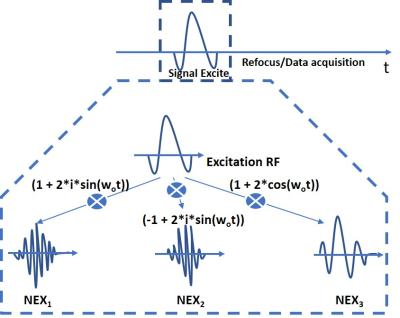 |
111 | Simultaneous Multi Slice using Hadamard like encoding with non-Hadamard factors
Sudhir Ramanna1, Harsh Agarwal1, Rajagopalan Sundaresan1, Sajith Rajamani1, Ashokkumar P Reddy1, Bhairav Mehta1, and Ramesh Venkatesan1
1GE Healthcare, Bangalore, India
Multiplexing of slices using the NEX/averaging dimension is an option for clinical MR protocols to improve SNR without imposing a scan time penalty. Hadamard encoding and decoding imposes Hadamard factors as limits where in only powers of 2 is used. We propose to use a Hadamard like encoding scheme but decode differently to yield a reduced effective NEX and improved motion sensitivity. This enables us to use any integer multiband factors.
|
||
2932 |
112 | Investigating a residual neural network to generated customizable RF pulses for MRI
Seger Nelson1 and Rebecca Emily Feldman2,3
1Computer Science, Mathematics, Physics, and Statistics, University of British Columbia, Kelowna, BC, Canada, 2Computer Science, Mathematics, Physics, and Statistics, University of British Columbia Okanagan, Kelowna, BC, Canada, 3Biomedical Engineering and Imaging Institute, Icahn School of Medicine at Mount Sinai, New York, NY, United States
We investigate a method for the design of radio frequency (RF) pulses for custom simultaneous multi slice spatial profiles. We trained a variation of residual neural networks on a dataset of 96,000 generated adiabatic “power independent of the number of slices” (PINS) RF pulses, varying parameters such as gradient duty cycle, number of pulse lobes, quadratic phase strength, and transition and filter bandwidth. We compared the direct-design RF pulses to those generated by our model.
|
||
2933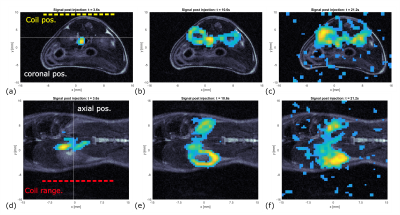 |
113 | B1-Compensating RF Excitation for Imaging hyperpolarized 13C nuclei with bSSFP using a 13C Cryo-Coil
Luca Nagel1, Geoffrey J. Topping1, and Franz Schilling1
1Department of Nuclear Medicine, TUM School of Medicine, Klinikum Rechts der Isar, Technical University of Munich, Munich, Germany Cryogenically cooled transmit/receive RF surface coils (cryocoils) can improve signal-to-noise ratio (SNR) up to 4X1. With flat profile RF pulses, surface coil excitation profiles are highly inhomogeneous, complicating the use of most pulse sequences, and especially the fast and efficient bSSFP sequence. A transmit B1-compensating RF pulse that produces uniform excitation with a Tx/Rx 13C cryo-coil was developed and tested in 3D-FLASH and 3D-bSSFP. Thermal 13C phantom imaging showed a regional uniform excitation, and proof-of-concept time-resolved 3D bSSFP imaging of hyperpolarized [13C]urea was demonstrated in mice. |
||
2934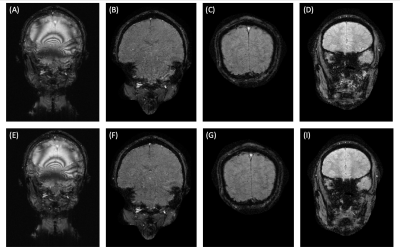 |
114 | Simultaneous Multislice Imaging Using Multiphoton MRI
Tanya Deniz Ipek1, Victor Han1, Jingjia Chen1, and Chunlei Liu1,2
1Electrical Engineering and Computer Sciences, University of California, Berkeley, Berkeley, CA, United States, 2Helen Wills Neuroscience Institute, University of California, Berkeley, Berkeley, CA, United States
Simultaneous multislice (SMS) imaging accelerates data acquisition by exciting several slices simultaneously but has a higher specific absorption rate (SAR) due to additional radiofrequency (RF) pulses required to excite multiple frequencies. Multiphoton excitation achieved by oscillating gradient fields provides frequency sidebands, eliminating the need for additional excitation pulses. We have demonstrated SMS imaging for multiphoton MRI and used SENSE reconstruction to separate simultaneously acquired slices with the help of coil sensitivity profiles. Multiphoton SMS images achieve a similar quality to standard one-photon SMS images but offer the benefit of reduced SAR as they do not require extra RF power.
|
||
2935 |
115 | Frequency-selective pTx pulses for 3D echo planar imaging at ultra-high field
Arun Joseph1,2,3, Patrick Liebig4, Gabriele Bonanno1,2,3, Jin Jin5,6, Kurt Majewski7, Tobias Kober8,9,10, and Tom Hilbert8,9,10
1Advanced Clinical Imaging Technology, Siemens Healthcare AG, Bern, Switzerland, 2Translational Imaging Center, sitem-insel AG, Bern, Switzerland, 3Magnetic Resonance Methodology, Institute of Diagnostic and Interventional Neuroradiology, University of Bern, Bern, Switzerland, 4Siemens Healthcare GmbH, Erlangen, Germany, 5Siemens Healthcare Pty Ltd, Brisbane, Australia, 6ARC Training Centre for Innovation in Biomedical Imaging Technology, The University of Queensland, Brisbane, Australia, 7Siemens AG, Munich, Germany, 8Advanced Clinical Imaging Technology, Siemens Healthcare AG, Lausanne, Switzerland, 9Department of Radiology, Lausanne University Hospital and University of Lausanne, Lausanne, Switzerland, 10LTS5, École Polytechnique Fédérale de Lausanne (EPFL), Lausanne, Switzerland
Echo planar imaging is an important MR technique used for different applications in both structural and functional imaging. It is typically used with fat suppression to avoid phase inconsistencies induced by the chemical shift of the fat signal. pTx pulses are used to mitigate the B1+ bias field occurring at higher fields strengths; typical pTx pulses do however not suppress the fat signal. In this work, we designed a frequency-selective water excitation pTx pulse to be used in 3D EPI acquisitions, enabling homogenous, high-resolution whole-brain fat-free imaging at 7T.
|
||
2936 |
116 | Velocity selective arterial spin labelling using parallel transmission
Chia-Yin Wu1,2,3, Jin Jin2,4, Carl Dixon1, Donald Maillet1, Markus Barth1,2,3, and Martijn Cloos1,2
1Centre for Advanced Imaging, The University of Queensland, Brisbane, Australia, 2ARC Training Centre for Innovation in Biomedical Imaging Technology, The University of Queensland, Brisbane, Australia, 3School of Information Technology and Electrical Engineering, The University of Queensland, Brisbane, Australia, 4Siemens Healthcare Pty Ltd, Brisbane, Australia
In this work, we demonstrate a parallel transmit implementation of velocity selective arterial spin labelling (VSASL) at 7 Tesla on a custom flow phantom developed in house. The use of tailored pTx pulses can greatly mitigate the transmit field inhomogeneities present at higher field strengths. By manipulating the time symmetry of the pTx pulses in the VSASL module we were able to show significant improvement in velocity selective inversion fidelity.
|
||
The International Society for Magnetic Resonance in Medicine is accredited by the Accreditation Council for Continuing Medical Education to provide continuing medical education for physicians.